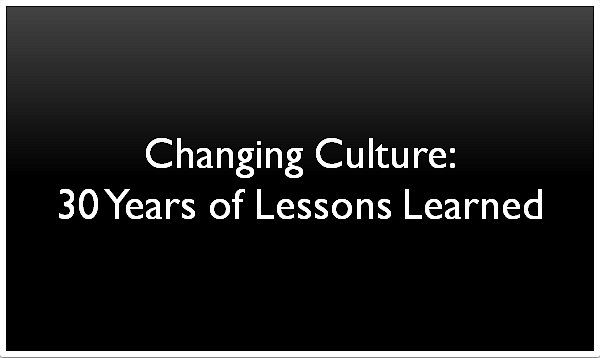
Leaders and Culture
Culture is created by shared experience, but it is the leader who initiates this process by acting out his or her beliefs, values, and assumptions in the behaviors he or she demonstrates and the practices he or she uses.
Anyone who has worked with a very good leader or a really bad one can clearly recall the effect that this individual had on the culture of their work group, division, function, or organization. Remember the ‘micro-manager’ that was constantly looking over your shoulder and telling you in agonizing detail how to do things or the leader that never ever made a decision? How did it impact the way people worked? Almost definitely, there wasn’t a lot of empowerment, the energy level in the group was low and people felt undervalued and disrespected.
On the other hand, many of us have been fortunate enough to work with leaders who have given people the freedom to make decisions within their area of responsibility and according to their capability level. How different is that? People are energized, feel empowered and take personal responsibility for their decisions. It seems obvious but most of us would much prefer the opportunity to work with leaders (anyone in a position of influence over others) who empower people rather than those that micro-manage. It affects our morale, productivity and performance. This is why it is extremely important that leaders are aware of the ways that their behaviors and the practices that they use, influence others, their work group and organization’s culture.
Leader Behaviors
Leaders, through their words and actions, send messages as to the right and expected way to interact and do things.
The good news is that leader behaviors and practices can be used in an intentional manner to accelerate culture change and strengthen alignment to strategy. This is not to suggest that changing behavior and practices is easy, but it is one of the most powerful tools that leaders have available to them. This is possible because people notice absolutely everything that a leader says and does. If a leader always arrives early for a meeting, his or her direct reports will do the same or risk the stigma of being unpunctual and disrespectful of others time. If the leader always wears the appropriate safety gear on a work site, people know this is important and they can likely expect censure if they don’t do the same.
Of course, the opposite is also true. A leader that blames someone else for his or her mistake is telling people that avoidance of responsibility for one’s actions is okay. We also see examples of both positive and negative messaging in what leaders say. Keep in mind that every word and action of a leader is carefully examined for subtle nuances and hidden meaning. However, not all leaders are created equal. The level of influence of a leader, or a leadership team, is directly related to the extent others perceive them to be authentic, credible, trustworthy and having integrity.
Authenticity: Genuineness or truth.
Credibility: The ability to inspire belief or trust.
Integrity: Possessing and steadfastly adhering to high moral principles or professional standards.
Trustworthiness: The belief that a person will not take advantage of another who puts him or herself in a vulnerable position.
At the core is the message that the leader genuinely believes in what he or she is doing and saying; that he or she is 100% committed in both words and actions to doing what he or he believes is needed; and that, at the same time, there is an overarching sense that he or she adheres to high moral principles and standards of behavior. In other words, this is someone that others can trust – period.
Leader Practices
Practices are the building blocks that define “the way that things are done around here”.
Leaders also impact culture by the practices that they use in performing their jobs and interacting with people. Practices are the repetitive patterns of activity essential to the smooth functioning of an organization. They cover a wide range of routines including the way leaders make decisions, run meetings and recognize people, just to name a few. They are the building blocks that help to shape “the way that things are done around here”. Practices are different from organizational processes which define how things are done. For example, a process might be the activities and tasks to complete in order to safely add new to a highway whereas a practice is the way this is done such as the use of concrete barriers to protect workers.
Shaping and Changing Culture
While culture change is not easy, it is possible to make it happen and achieve concrete results in a matter of months and not years as popularly believed. We’ve seen numerous examples in all sizes of companies across a wide range of industries and sectors that support this statement. In some cases, the change is dramatic and others less so but, in all cases, leaders were the catalyst for the change that occurred. How did they do it?
The leaders used a combination of their own behaviors and a set of practices carefully selected to fit their purpose. In one case, the leader was frustrated by a lack of discipline that he believed was negatively affecting productivity and his department’s ability to meet its objectives. He decided that he was going to do something about it. Within his work group, he introduced practices designed to bring more discipline into the way people worked. The leader reinforced these practices with his own behaviors. For example, he made it clear that people were expected to be on time for meetings and scheduled appointments, no exceptions and no excuses. To this end, he introduced the following practices and behaviors:
- Practice 1: Meetings started and ended exactly at the scheduled time. If the meeting was to start at 9:00 a.m., he locked the room door and started the meeting. People were not allowed to enter the meeting after it started. This included his boss and other senior people. It caused quite a stir at the beginning!
- Practice 2: Appointment times were strictly adhered to. If someone was late for an appointment, the appointment was automatically cancelled. This was a big deal as it was extremely difficult getting time booked with the leader who spent a lot of time at work sites. It could be weeks before people had another chance to meet with him.
- Behavior: The leader always arrived at least 5 minutes early for every meeting. If it was someone else’s meeting, he would wait 10 minutes and if the meeting hadn’t started, he would leave. Initially, this was a problem with his boss and his boss’ peers in other groups however he was able to manage the issue by agreeing to return to meetings if required. He made his point swiftly and effectively.
- Result: Within days, people began to show up on time for their appointments. Within a few weeks, people consistently arrived on time for meetings and not just his meetings but also meetings hosted by his boss and others in the organization. Meetings became more efficient and effective and people appreciated that they could depend on the fact that the meetings would always end on time.
He also introduced a number of other practices which he supported through his own behavior. Many of these were small like the ones in this example but the results were huge. Although the change started small with only one department, the change in performance of that department drew attention to what the leader was doing. Soon other departments began to follow suit and within a matter of a few months a significant shift in culture had taken root across the organization.
In Summary
The Good News:
You may not have the power to change the culture of the whole organization, but you can change the culture in your work area and, perhaps, influence the culture of the department, division, region and even the organization.
- Leaders can use their words and actions in an intentional and purposeful way to influence the norms of behavior in use in their organizations and thereby shape culture.
- When a critical mass of leaders purposefully and authentically demonstrates the same core set of behaviors, the potential for positive change increases dramatically.
- Every leader can change practices that are part of the way that work is done on a day-to-day basis.
The Challenge:
Using leader behaviors and practices in a purposeful and mindful way to shape culture requires…
- A high level of self-awareness that only comes from deep personal reflection which is a skill that few of us have and needs to be developed and honed.
- A high level of constant vigilance to notice how one’s words and actions are influencing the behaviors of others and to pick up on the subtle clues and messages that people provide.
- The courage to stand by one’s convictions and the tenacity to stick with it for the long term.
- The organizational acumen to make sure that your plans don’t get derailed by people at higher levels.
Dr. Nancie Evans
Dr. Nancie Evans is co-founder and VP Client Solutions at Culture-Strategy Fit Inc. specializing in the alignment of organizational culture and strategy. She has developed a unique set of leading-edge diagnostic tools and approaches that provide leaders with deep insights into the culture of their organizations, how it is supporting or getting in the way of strategy execution, as well as the levers that they can use to drive rapid culture change.
CULTURESTRATEGYFIT®
Culture-Strategy Fit Inc. is a leading culture and executive leadership consulting firm conducting groundbreaking work in leveraging culture to drive strategy and performance. Its suite of culture surveys and culture alignment tools are used by market-leading organizations around the world.
Contact Us
www.culturestrategyfit.com
1.800.976.1660
nancie@culturestrategyfit.com
© CULTURE STRATEGY FIT ® All rights reserved









